Acapulco, Guerrero 作者: 来源: 发布时间:2021-11-15
1.Population and Area
Pop: 687,608 (city)
Area: 1,880.60 km2 (city)
Elev: 30 masl
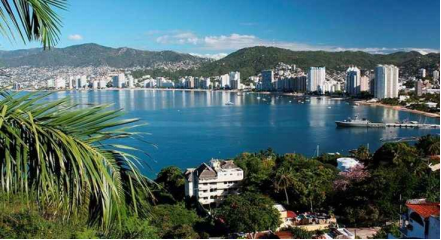
Acapulco location in Mexico within the state of Guerrero
https://goo.gl/maps/9haWspUmwQBxiXyc6
2. Natural geography
Nature and weather
The city, located on the Pacific coast of Mexico in the state of Guerrero, is classified as one of the state's seven regions, dividing the rest of the Guerrero coast into the Costa Grande and the Costa Chica. Forty percent of the municipality is mountainous terrain; another forty percent is semi-flat; and the other twenty percent is flat. Altitude varies from sea level to 1,699 metres (5,574 feet). The highest peaks are Potrero, San Nicolas, and Alto Camarón. One major river runs through the municipality, the Papagayo, along with a number of arroyos (streams). There are also two small lagoons, Tres Palos and Coyuca, along with a number of thermal springs.
Flora and fauna
The flora of the municipality in almost most of its territory is the Lower Deciduous Forest, which is made up of various emulated bursera germs, liay loma (tepehuaje), jucartia mexicana (bonnet), imposes (casahuate), bombax (pochote). In some areas of the highlands there are areas of pine and oak forest. There is also the development of activities such as agriculture, specifically in the southeast area of the municipality. fruit trees: coconut palms, tamarinds, nanches, guava, almond trees, pomegranates, plums and mangoes.
Fauna: In relation to fauna, there is a rabbit, iguana, badger, skunk, raccoon, deer, buzzard, carrot, turtledove, pigeon, hawk, pelican, parakeet, seagull, heron, sea turtle, crocodile, trout, and other small mammals.
Köppen Classification: Tropical Savanna Climate
Tropical savanna climates have monthly mean temperature above 18°C (64°F) in every month of the year and typically a pronounced dry season, with the driest month having precipitation less than 60mm (2.36 in) of precipitation. In essence, a tropical savanna climate tends to either see less rainfall than a tropical monsoon climate or have more pronounced dry seasons than a tropical monsoon climate. Tropical savanna climates are most commonly found in Africa, Asia and South America. The climate is also prevalent in sections of Central America, northern Australia and North America, specifically in sections of Mexico and the state of Florida in the United States.
The Köppen Climate Classification subtype for this climate is "Aw". (Tropical Savanna Climate).
The average amount of precipitation for the year in Acapulco - Centro is 51.4" (1305.6 mm). The month with the most precipitation on average is September with 12.8" (325.1 mm) of precipitation. The month with the least precipitation on average is April with an average of 0.0" (0 mm). In terms of liquid precipitation, there are an average of 61.0 days of rain, with the most rain occurring in September with 13.9 days of rain, and the least rain occurring in March with 0.2 days of rain. precipitation, there are an average of 89.4 days of rain, with the most rain occurring in July with 22.2 days of rain, and the least rain occurring in March with 0.4 days of rain.
https://www.weatherbase.com/weather/weather-summary.php3?s=912201&cityname=Acapulco+-+Centro%2C+Guerrero%2C+Mexico&units=
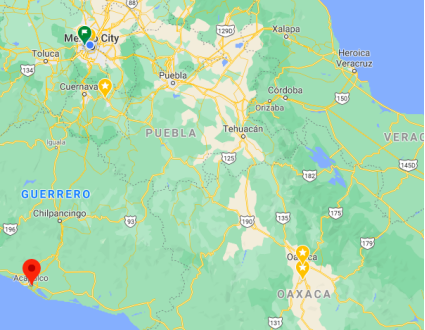
Getting there and around
Get there
By plane
From Mexico, you can fly to Acapulco from Mexico City or Guadalajara. You can also connect to Acapulco from various cities in the USA. The airport is 20 minutes south-east of Acapulco’s central area. Ground transportation options, including taxis, car rentals and shuttles, are available from the airport. Local colectivos will also take you into town for an affordable price.
By car
The drive to Acapulco on the toll road from Mexico City is fast and efficient, taking about four hours. The Toll Road is Highway 95 – the same one the first-class bus takes; a very scenic route that includes driving across the suspension bridge over the Río Balsas, the largest of four suspension bridges on the highway. There is a free road you can take as an alternative to the toll highway, but this will inevitably be slower, and we recommend you take the toll road for efficiency and safety.
By bus – Buses run all day from Mexico City’s Central de Autobuses del Sur to Acapulco’s main bus station. The journey distance is about 180 miles and will take about five hours. There are two bus terminals in Acapulco; Estrella de Oro (the company which runs the very comfortable “Diamante” (Diamond) service to and from Mexico City) has a separate terminal a few blocks from the main station.
https://www.mexperience.com/travel/beaches/acapulco
Car Rental – To explore Mexico’s provincial towns and cities—including its beach locations and the scenery and attractions near them— consider renting a car for your visit. Having your own car will give you more flexibility than using public transport options and, in some cases, offer you access to places which are otherwise difficult to visit without the use of a car.
COVID19 - International entry into Mexico from United States
Allowed for: All visitors arriving by air. Mexico land borders are closed to non-essential travel
Restricted for: There are no current restrictions.
Get around
Local Buses – Local buses and mini-buses (combis or micros) are available locally for a fraction of the cost of a taxi around town. You need to speak Spanish to be able to ask for directions or ask the driver to tell you where to get off.
Taxis – Taxis in most of Mexico’s towns and cities are not metered, so agree your price before you get in. Taxi travel is very affordable in Mexico, in comparison to the USA, Canada and Europe, and so provides a viable means of public transportation in Mexico. Your hotel can arrange taxis for you; some post their rates on a board in the lobby; taxi hotel rates are usually higher than cabs you hail off the street. If you speak Spanish, you will have a distinct advantage and be able to negotiate a price with the driver.
Uber is expanding rapidly across Mexico and now offers services in cities across the country, including: Mexico City, Toluca, Cuernavaca, Puebla, Querétaro, León, Aguascalientes, San Luis Potosí, Guadalajara, Monterrey, Hermosillo, Tijuana, Mexicali, and Mérida. Uber has been adding Mexican cities to its network every year, check for availability when you arrive at your destination in Mexico.
Cabify and Didi are also developing and currently operate in cities including Mexico City, Toluca, Monterrey, Puebla, Querétaro and Tijuana. Check for availability in the city you are visiting.
These services offer people with smartphones a way to book a cab through a mobile app for a pre-agreed price. Fares are comparable with Sitio type cabs, and sometimes trade at a premium to this when local demand increases.
https://www.mexperience.com/transport/taxi-travel-in-mexico/#51
3. ECONOMY
GDP: 54841.2 M MXN (2010)
https://www.researchgate.net/publication/323024442_Estimacion_no-parametrica_del_producto_interno_bruto_de_los_municipios_de_Mexico
4. Industry characteristics
Tourism is the main economic activity of the municipality and most of this is centered on Acapulco Bay. About seventy-three percent of the municipality's population is involved in commerce, most of it related to tourism and the port. Mining and manufacturing employ less than twenty percent and only about five percent is dedicated to agriculture. Industrial production is limited mostly to bottling, milk products, cement products, and ice and energy production. Agricultural products include tomatoes, corn, watermelon, beans, green chili peppers, and melons.
Acapulco is one of Mexico's oldest coastal tourist destinations, reaching prominence in the 1950s as the place where Hollywood stars and millionaires vacationed on the beach in an exotic locale. In modern times, tourists in Acapulco have been facing problems with corrupt local police who steal money by extortion and intimidate visitors with threats of jail.
The city is divided into three tourist areas.
Traditional Acapulco is the old part of the port, where hotels like Hotel Los Flamingos, owned by personalities Johnny Weissmuller and John Wayne are located, is on the northern end of the bay. Anchored by attractions such as the beaches of Caleta and Caletilla, the cliff divers of La Quebrada, and the city square, known as El Zocalo. The heyday of this part of Acapulco ran from the late 1930s until the 1960s, with development continuing through the 1980s.[46][42] This older section of town now caters to a mostly middle-class, almost exclusively Mexican clientele, while the glitzier newer section caters to the Mexican upper classes, many of whom never venture into the older, traditional part of town.
Acapulco Dorado had its development between the 1950s and the 1970s, and is about 25 minutes from the Acapulco International Airport. It is the area that presents the most tourist influx in the port, runs through much of the Acapulco bay, from Icacos, passing through Costera Miguel Aleman Avenue, which is the main one, to Papagayo Park. It has several hotels,
Acapulco Diamante, also known as Punta Diamante, is the newest and most developed part of the port, with investment having created one of the greatest concentrations of luxury facilities in Mexico, including exclusive hotels and resorts of international chains, residential complexes, luxury condominiums and private villas, spas, restaurants, shopping areas and a golf course. Starting at the Scenic Highway in Las Brisas, it includes Puerto Marqués and Punta Diamante and extends to Barra Vieja Beach. It is 10 minutes from the Acapulco International Airport. In this area, all along Boulevard de las Naciones, almost all transportation is by car, limousine or golf cart.
Acapulco's reputation of a high-energy party town and the nightlife have long been draws of the city for tourists. From November to April, luxury liners stop here daily and include ships such as the MS Queen Victoria, the MS Rotterdam, Crystal Harmony, and all the Princess line ships. Despite Acapulco's international fame, most of its visitors are from central Mexico, especially the affluent from Mexico City. Acapulco is one of the embarkation ports for the Mexican cruise line Ocean Star Cruises.
For the Christmas season of 2009, Acapulco received 470,000 visitors, most of whom are Mexican nationals, adding 785 million pesos to the economy. Eighty percent arrive by land and eighteen percent by air. The area has over 25,000 condominiums, most of which function as second homes for their Mexican owners. Acapulco is still popular with Mexican celebrities and the wealthy, such as Luis Miguel and Plácido Domingo, who maintain homes there.
Industry
Historically, in the municipality of Acapulco, the industry has not had a dynamic development, mainly due to the lack of investment orientation, which has led to the existence of small artisanal establishments, such as silver shops, sewing workshops, blacksmiths , carpentry, shawls, typical clothing, palm items, among others; contrasting with a small number of garment maquiladoras for export, counting in the entity with spaces available for the installation of industrial parks. Likewise, there are soft drink bottlers, a milk pasteurizer, a cement factory, an ice factory, a lemon processing plant, a soap factory, electricity generating plants and the oil industry, which due to lack of investment have had to close .
Commerce
Popular markets, retail product stores, pharmacies, shoe stores, clothing stores, supply stores, supermarkets and recyclable materials, etc., is also decisive for municipal development, since it provides the necessary inputs for the operation of the tertiary activity, as well as providing and guaranteeing the supply of the population with products necessary for the well-being of the inhabitants.
Farming
Since ancient times, thanks to agriculture, but above all, through the mastery of soil cultivation techniques for the controlled obtaining of vegetables, it was found that the main crops in the Municipality. Considering the volume of municipal production obtained in the most important cyclical and perennial crops, it is clear that most of it is destined for commercialization, with the exception of corn, which is largely used for self-consumption.
66.5% of the total area of the municipality is covered by vegetation, while the rest 33.5% is transformed. As regards agriculture and given the low capacity of the soils for this activity, the proportion remains at 13.11% of the municipal territory, as for the coniferous and broadleaf forest it remains with 13.57%; The grassland represents 12.36%, this proportion is very similar to the agricultural area, the forests occupy 46.16%.
The urban area and infrastructure occupy 8.02%. In the case of the territory of the municipality of Acapulco de Juárez, the area with agricultural aptitude of class 1, covers only 1.95% of the total municipal area (42 185 hectares); In the case of the area with agricultural class 2, it does not appear in this municipality; Class 3 agricultural aptitude is distributed in 40.49%; The area with agricultural aptitude class 4, is distributed in 53.94% of the municipal territory, which are soils of very low or no agrological quality.
Fishing
Fishing in Acapulco is one of the most popular activities; In addition, visitors can hire one of the different services offered by marlin and sailfish fishing tours and excursions.
The municipality has incipient fishing, an activity that is mainly maintenance on the coastlines of the area, having different species, such as: sailfish, marlin, dorado, tuna, Wahoo, roosterfish, snook, among others. The Tres Palos Lagoon is one of the main areas for fishing in Acapulco, thanks to the mangroves that attract countless birds that are present to feed in its waters. Another option is Puerto Marqués, where sports fishing is practiced for sailfish, snook, skipjack and many more.
The Chautengo Lagoon is an optimal place to carry out this activity, since the Copala and Nexpan rivers flow into it, bringing numerous species of fresh water that inhabit this region of Mexico. La Laguna de Coyuca, one of the most important spaces dedicated to this sport, with typical species of the area. In addition, there are tours and boat trips to the Isle of Man of the 7 Wives and the Isle of Birds.
Cattle raising
According to Sagarpa 2013, bovine livestock activity in the municipality has not been developed on a commercial scale, only extensively, lately cattle have been acquired from other parts of the State to strengthen said activity. There are small farmers who practice extensive traditional livestock, with limited financial resources and with a reduced negotiation capacity, when marketing their products. It is important to mention that there is no municipal slaughterhouse, only tolerated slaughterhouses operate in the municipality, which does not allow control over the slaughter of animals. These establishments do not have adequate facilities for individuals to sacrifice animals, using the most convenient procedures for the consumption of the population.
The dominant pig farming in the municipality, is the backyard, falls within the productive chains of the peasant and suburban type in small farms, without adequate specialization in the breeding and fattening of animals, the process usually requires more than 180 days; It is estimated that it maintains more than 60% of the production in the municipality, with a diet based on waste and waste in general.
Key project: Papagayo Park restoration and expansion
Papagayo Park, one of the most representative of Acapulco, Guerrero, will be rescued as part of the Urban Improvement Program of the Ministry of Agrarian, Territorial and Urban Development (Sedatu) in coordination with the state government. With an investment of 300 million pesos, progressive improvements will be made, announced in January Román Meyer, head of the agency.
It is an area of 22 hectares of extension, located in the center of the city, with a front of 800 meters towards the sea, currently it is in a general state of deterioration and lack of maintenance generated mainly by concessions, inadequate leases and Obsolete infrastructure, which is why a master plan based on a new image of the park is proposed, with the aim of strengthening it as a strong tourist attraction offering programs, recreational, social and community-building activities.
The project plans to reduce and prioritize the main accesses, which used to be 13, to reduce them to five: on the Costera Miguel Alemán, on Juan Sebastián el Cano street, on Cuauhtémoc avenue and Manuel Gómez Morín street, in addition to one more entrance in the latter street to a food court.
Another of the main areas of improvement is the perimeter fence. Before the remodeling, which began in early 2020, it was faced with poor-quality concessions and leases that occupied urban edges, in addition to a discontinuous and battered trellis, the institution reports. So the Sedatu proposes an integral design that allows visual transparency towards the interior of the park.
The pedestrian paths will also be improved, as they currently lack quality; They are truncated and invaded roads towards the hill and do not contribute to universal accessibility. To solve this, secondary routes will be integrated that allow exploring different plant scenarios.
Within the project there is also a new network of hydro sanitary and electrical installations, since the current ones, which have been in operation for 38 years, are not physically identified, and the rainwater and drainage networks are mixed.
Likewise, seven specific areas will be determined for various activities: sports, recreational, water, social, cultural, food, shade, parking and administrative. Regarding the sports sector, there will be two 7-a-side football fields, two basketball / volleyball courts, a covered room for theoretical classes, bathrooms and dressing rooms, and a snack area.
The Master Plan also includes a skatepark, wading pools, cabins and children's play areas, as well as a social center, open-air forum, a digital library, audiorama and a forum on the fountain’s esplanade.
https://obras.expansion.mx/infraestructura/2020/08/03/asi-quedara-el-parque-papagayo-en-acapulco-tras-rescate
5. Attractions
Cliff Divers at La Quebrada
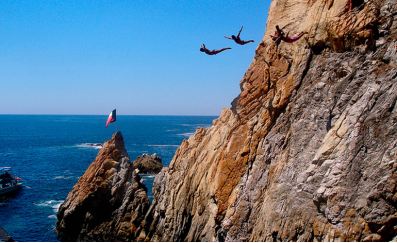
This spectacle is one of Acapulco’s most famous attractions. Some believe that a visit to Acapulco might be incomplete if you missed the world-famous cliff dives at La Quebrada (“The Break”).
At La Quebrada, divers plunge off cliffs some 130 feet high into a cove that is only safe to dive in when the wave comes in. Wrong timing would result in a fatal fall.
Dives are scheduled at 1 pm, and in hours of darkness at 7 pm, 8:30 pm, 9:30 pm, 10:30 pm. At night the divers carry torches to light their descent which is quite a spectacle in its own right.
Dives may be viewed from balconies near the cove for a small entrance fee. Alternatively, there is a hotel nearby, called El Mirador, which has a Restaurant-Bar called La Perla. You can watch the divers while eating your meal or if you buy a drink at the bar.
Some people take a boat trip to La Quebrada, drop anchor, and watch the divers from there; most of the boats are privately owned although if you wanted to see the divers from this perspective you could hire a boat and crew.
Pie de la cuesta
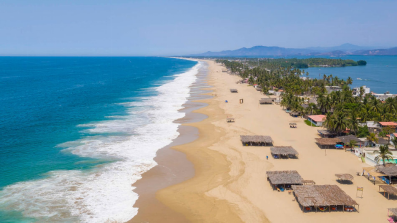
Pie de la Cuesta is about six miles northwest of Acapulco’s center and consists of a strip of land with the Pacific ocean on one side and a freshwater lake (Laguna de Coyuca) on the other.
This location is quiet and serene in comparison to the center of Acapulco. If you want to swim, swim in the lake—the sea here is dangerous, and people have been killed in the surf. Other popular activities on the lagoon include boating and water skiing. You can hire the equipment locally.
Pie de la Cuesta has a lot of seafood restaurants on the beach side, and there’s a good reason for that: The sunset here is spectacular!
If you want to stay in this area (close to Acapulco proper, but far enough away to get some peace and tranquility) there are several places to stay nearby.
Bellavista ex-textile factory
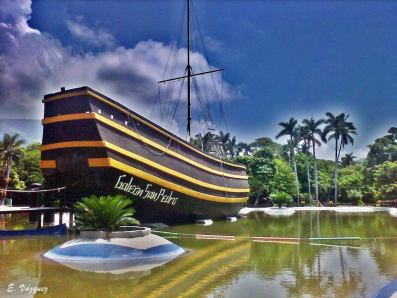
This is a large amusement and activities park, which also leads to two beaches: Playa Hornos and Playa Hornitos. Its features include a lake with paddle boats for rent, a roller-skating rink, a fair with mechanical rides, an animal enclosure and aviary and a pathway (circular circuit) which is over one km in length — good if you like a morning run. There is no admission charge to enter the park and it’s open from 6 am to 8 pm daily. The mechanical rides open later between 4 pm and 11 pm.
https://www.mexperience.com/travel/beaches/acapulco
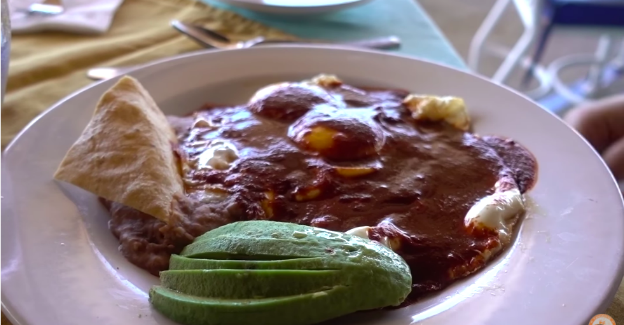
ACAPULCO, MEXICO | One of the most dangerous places in the world?!
https://youtu.be/uVS11ghR7V0
6. History
Pre-Columbian
By the 8th century around the Acapulco Bay area, there was a small culture which would first be dominated by the Olmecs, then by a number of others during the pre-Hispanic period before it ended in the 1520s. At Acapulco Bay itself, there were two Olmec sites, one by Playa Larga and the other on a hill known as El Guitarrón. Olmec influence caused the small spread-out villages here to coalesce into larger entities and build ceremonial centers.
Later, Teotihuacan influence made its way here via Cuernavaca and Chilpancingo. Then Mayan influence arrived from the Isthmus of Tehuantepec and through what is now Oaxaca. This history is known through the archaeological artifacts that have been found here, especially at Playa Hornos, Pie de la Cuesta, and Tambuco.
In the 11th century, new waves of migration of Nahuas and Coixas came through here. These people were the antecedents of the Aztecs. In the later 15th century, after four years of military struggle, Acapulco became part of the Aztec Empire during the reign of Ahuizotl (1486–1502). It was annexed to a tributary province named Tepecuacuilco. However, this was only transitory, as the Aztecs could only establish an unorganized military post at the city's outskirts. The city was in territory under control of the Yopes, who continued defending it and living there until the arrival of the Spanish in the 1520s.
16th century
There are two stories about how Acapulco bay was discovered by Europeans. The first states that two years after the Spanish conquest of the Aztec Empire, Hernán Cortés sent explorers west to find gold. The explorers had subdued this area after 1523, and Captain Saavedra Cerón was authorized by Cortés to found a settlement here. The other states that the bay was discovered on December 13, 1526 by a small ship named the El Tepache Santiago captained by Santiago Guevara. The first encomendero was established in 1525 at Cacahuatepec, which is part of the modern Acapulco municipality. In 1531, a number of Spaniards, most notably Juan Rodriguez de Villafuerte, left the Oaxaca coast and founded the village of Villafuerte where the city of Acapulco now stands. Villafuerte was unable to subdue the local native peoples, and this eventually resulted in the Yopa Rebellion in the region of Cuautepec. Hernán Cortés was obligated to send Vasco Porcayo to negotiate with the indigenous people giving concessions. The province of Acapulco became the encomendero of Rodriguez de Villafuerte who received taxes in the form of cocoa, cotton and corn.
Cortés established Acapulco as a major port by the early 1530s, with the first major road between Mexico City and the port constructed by 1531. The wharf, named Marqués, was constructed by 1533 between Bruja Point and Diamond Point. Soon after, the area was made an "alcadia" (major province or town).
Spanish trade in the Far East would give Acapulco a prominent position in the economy of New Spain. In 1550 thirty Spanish families were sent to live here from Mexico City to have a permanent base of European residents. Galleons started arriving in Acapulco from Asia by 1565. Acapulco would become the second most important port, after Veracruz, due to its direct trade with the Philippines. This trade would focus on the yearly Manila-Acapulco Galleon trade, which was the nexus of all kinds of communications between New Spain, Europe and Asia. In 1573, the port was granted the monopoly of the Manila trade.
17th–19th centuries
The galleon trade made its yearly run from the mid-16th century until the early 19th. The luxury items it brought to New Spain attracted the attention of English and Dutch pirates, such as Francis Drake, Henry Morgan and Thomas Cavendish, who called it "The Black Ship". A Dutch fleet invaded Acapulco in 1615, destroying much of the town before being driven off. The Fort of San Diego was built the following year to protect the port and the cargo of arriving ships. The fort was destroyed by an earthquake in 1776 and was rebuilt between 1778 and 1783.
At the beginning of the 19th century, King Charles IV declared Acapulco a Ciudad Official and it became an essential part of the Spanish Crown. However, not long after, the Mexican War of Independence began. In 1810, José María Morelos y Pavón attacked and burnt down the city, after he defeated royalist commander Francisco Parés at the Battle of Tres Palos. The independence of Mexico in 1821 ended the run of the Manila Galleon. Acapulco's importance as a port recovered during the California Gold Rush in the mid-19th-century, with ships going to and coming from Panama stopping here. This city was the besieged on 19 April 1854 by Antonio López de Santa Anna after Guerrero's leadership had rebelled by issuing the Plan de Ayutla. After an unsuccessful week of fighting, Santa Anna retreated.
20th century
In 1911, revolutionary forces took over the main plaza of Acapulco. In 1920, the Prince of Wales (the future King Edward VIII) visited the area. Impressed by what he saw, he recommended the place to his compatriots in Europe, making it popular with the elite there. Much of the original hotel and trading infrastructure was built by a businessman named Albert B. Pullen from Corrigan, Texas, in the area now known as Old Acapulco. In 1933 Carlos Barnard started the first section of Hotel El Mirador, with 12 rooms on the cliffs of La Quebrada. Wolf Schoenborn purchased large amounts of undeveloped land and Albert Pullen built the Las Americas Hotel.
In the mid-1940s, the first commercial wharf and warehouses were built. In the early 1950s, President Miguel Alemán Valdés upgraded the port's infrastructure, installing electrical lines, drainage systems, roads and the first highway to connect the port with Mexico City.
The economy grew and foreign investment increased with it. During the 1950s, Acapulco became the fashionable place for millionaire Hollywood stars such as Elizabeth Taylor, Frank Sinatra, Eddie Fisher and Brigitte Bardot. The 1963 Hollywood movie Fun in Acapulco, starring Elvis Presley, is set in Acapulco although the filming took place in the United States. Former swing musician Teddy Stauffer, the so-called "Mister Acapulco", was a hotel manager ("Villa Vera", "Casablanca"), who attracted many celebrities to Acapulco.
From a population of only 4,000 or 5,000 in the 1940s, by the early 1960s, Acapulco had a population of about 50,000. In 1958, the Diocese of Acapulco was created by Pope Pius XII. It became an archdiocese in 1983.
During the 1960s and 1970s, new hotel resorts were built, and accommodation and transport were made cheaper. It was no longer necessary to be a millionaire to spend a holiday in Acapulco; the foreign and Mexican middle class could now afford to travel here. However, as more hotels were built in the south part of the bay, the old hotels of the 1950s lost their grandeur. For the 1968 Summer Olympics in neighboring Mexico City, Acapulco hosted the sailing (then yachting) events.
In the 1970s, there was a significant expansion of the port.
The Miss Universe 1978 pageant took place in the city. In 1983, singer-songwriter Juan Gabriel wrote the song "Amor eterno", which pays homage to Acapulco. The song was first and most famously recorded by Rocio Durcal. Additionally, Acapulco is the hometown of actress, singer, and comedian Aída Pierce, who found fame during the 1980s, 1990s and the first decade of the 21st century.
The tollway known as the Ruta del Sol was built during the 1990s, crossing the mountains between Mexico City and Acapulco. The journey takes only about three-and-a-half hours, making Acapulco a favorite weekend destination for Mexico City inhabitants. It was in that time period that the economic impact of Acapulco as a tourist destination increased positively, and as a result new types of services emerged, such as the Colegio Nautilus. This educational project, backed by the state government, was created for the families of local and foreign investors and businessmen living in Acapulco who were in need of a bilingual and international education for their children.
The port continued to grow and in 1996, a new private company, API Acapulco, was created to manage operations. This consolidated operations and now Acapulco is the major port for car exports to the Pacific.
The city was devastated by Hurricane Pauline in 1997. The storm stranded tourists and left more than 100 dead in the city. Most of the victims were from the shantytowns built on steep hillsides that surround the city. Other victims were swept away by thirty-foot waves and 150 mph (240 km/h) winds. The main road, Avenida Costera, became a fast-moving river of sludge three feet in depth.
21st century
In the 21st century, the Mexican Drug War has had a negative effect on tourism in Acapulco as rival drug traffickers fight each other for the Guerrero coast route that brings drugs from South America as well as soldiers that have been fighting the cartels since 2006.
A major gun battle between 18 gunmen and soldiers took place in the summer of 2009 in the Old Acapulco seaside area, lasting hours and killing 16 of the gunmen and two soldiers. This came after the swine flu outbreak earlier in the year nearly paralyzed the Mexican economy, forcing hotels to give discounts to bring tourists back. However, hotel occupancy for 2009 was down five percent from the year before. The death of Arturo Beltran Leyva in December 2009 resulted in infighting among different groups within the Beltran Leyva cartel.
Gang violence continued to plague Acapulco through 2010 and into 2011, most notably with at least 15 dying in drug-related violence on March 13, 2010, and another 15 deaths on January 8, 2011. Among the first incident's dead were six members of the city police and the brother of an ex-mayor. In the second incident, the headless bodies of 15 young men were found dumped near the Plaza Sendero shopping center. On August 20, 2011, Mexican authorities reported that five headless bodies were found in Acapulco, three of which were placed in the city's main tourist area and two of which were cut into multiple pieces.
On February 4, 2013, six Spanish men were tied up and robbed and the six Spanish women with them were gang-raped by five masked gunmen who stormed a beach house on the outskirts of Acapulco, though after these accusations, none of the victims decided to press charges. On September 28, 2014, Mexican politician Braulio Zaragoza was gunned down at the El Mirador hotel in the city. He was the leader of the conservative opposition National Action Party (PAN) in southern Guerrero state. Several politicians have been targeted by drug cartels operating in the area. Investigations are under way, but no arrests have yet been made. The insecurity due to individuals involved with drug cartels has cost the city of Acapulco its popularity among national and international tourists. It was stated by the Dirección General de Aeronáutica Civil that the number of international flyers coming to Acapulco decreased from 355,760 flyers registered in 2006 to 52,684 flyers in the year 2015, the number of international tourists flying to Acapulco dropped 85% in the interval of nine years.
7.Contact Information

City Mayor: Adela Román Ocampo
Contact number: +52 (744) 440 7000
Govt. Office Address: Av. Cuauhtémoc S/N, Interior Parque Papagayo, Fracc. Hornos.
FB: https://www.facebook.com/AdelaRomanOficial
Twitter: https://twitter.com/Adela_Roman
Website: https://acapulco.gob.mx
